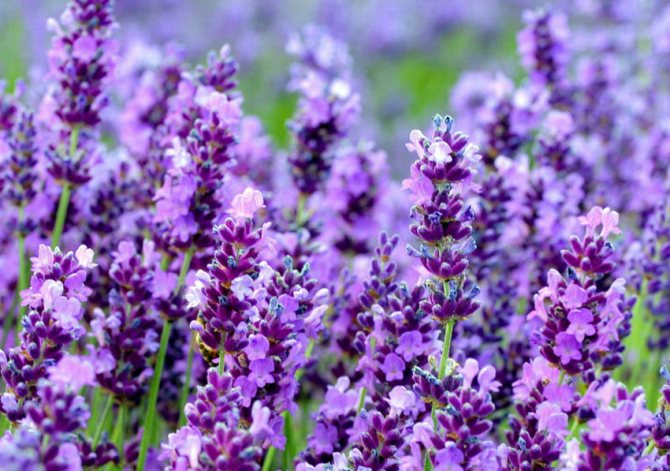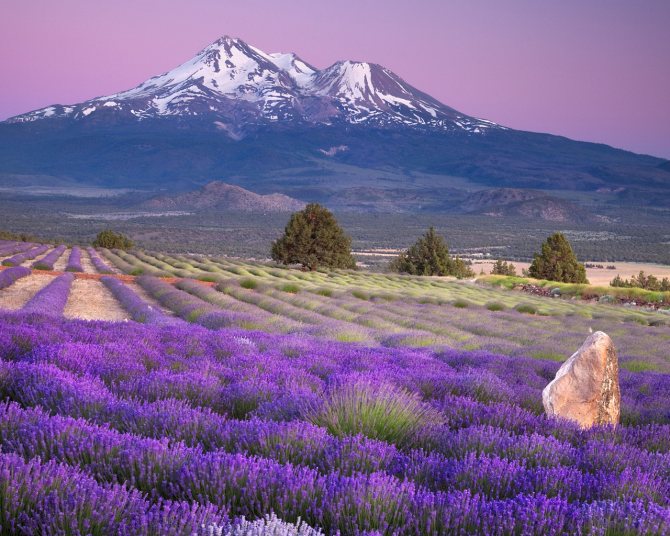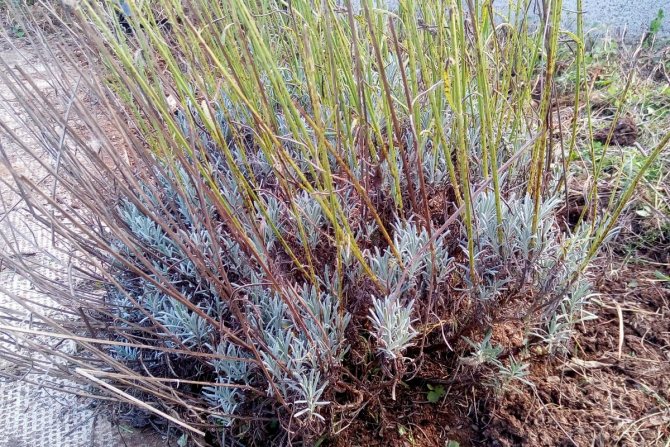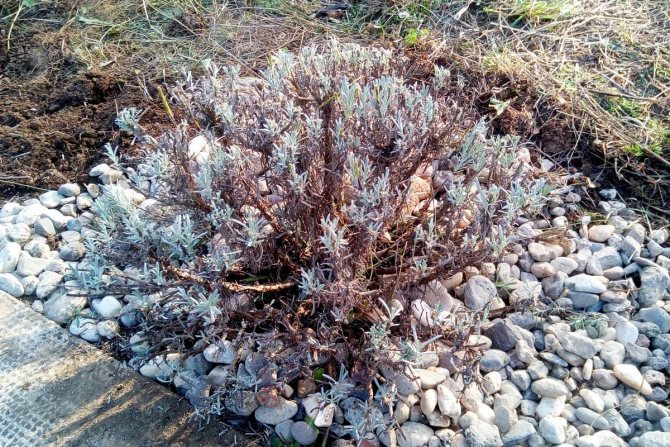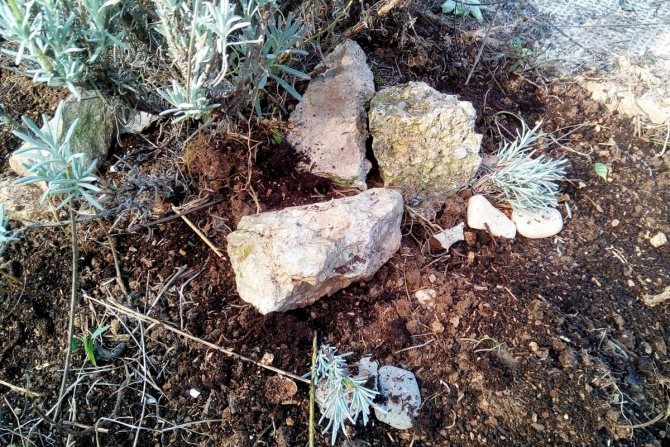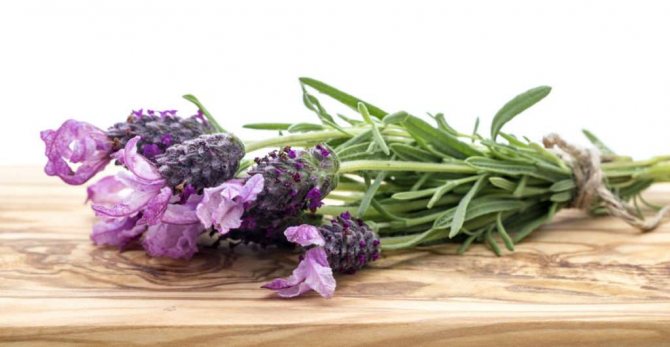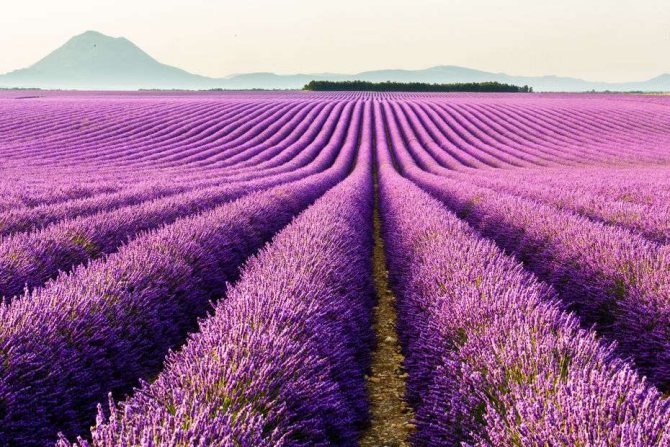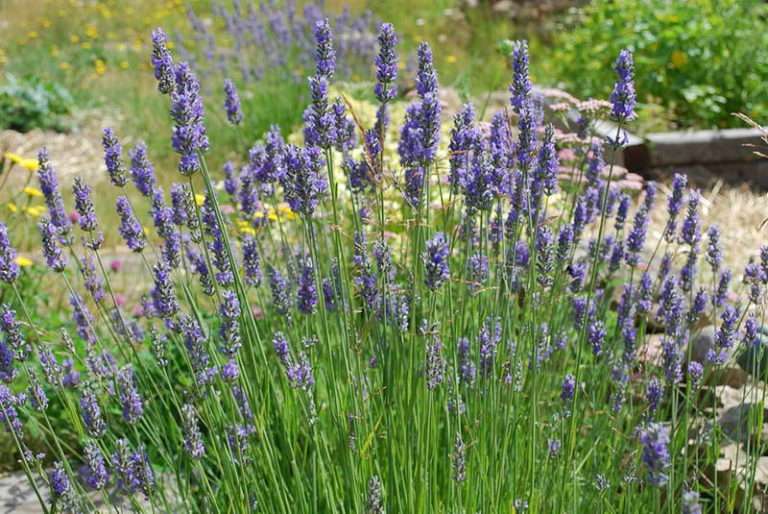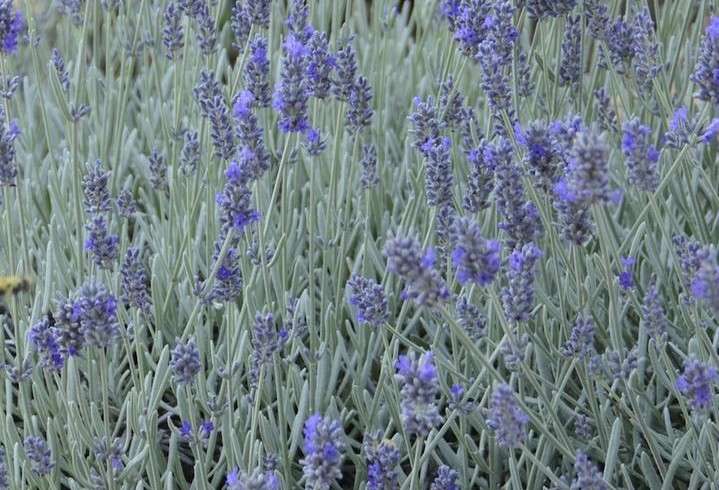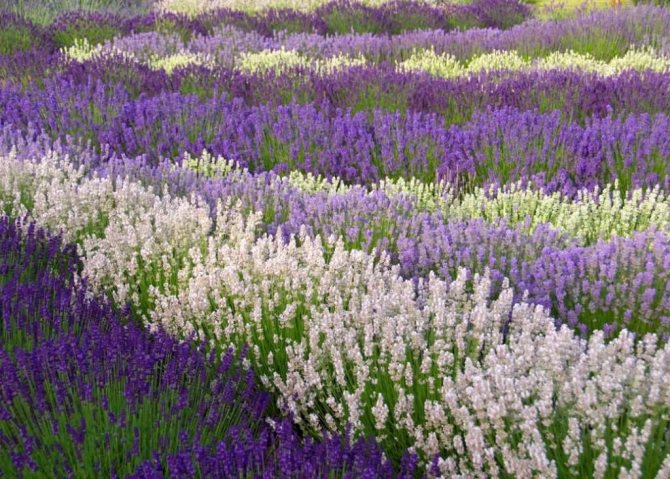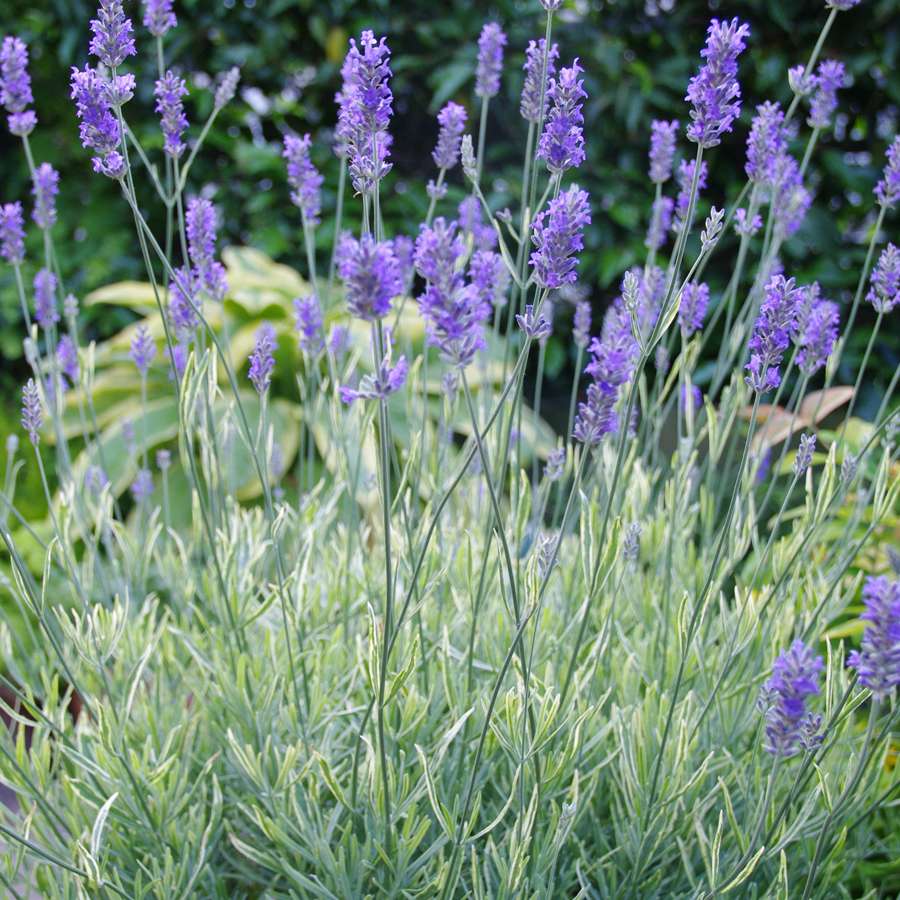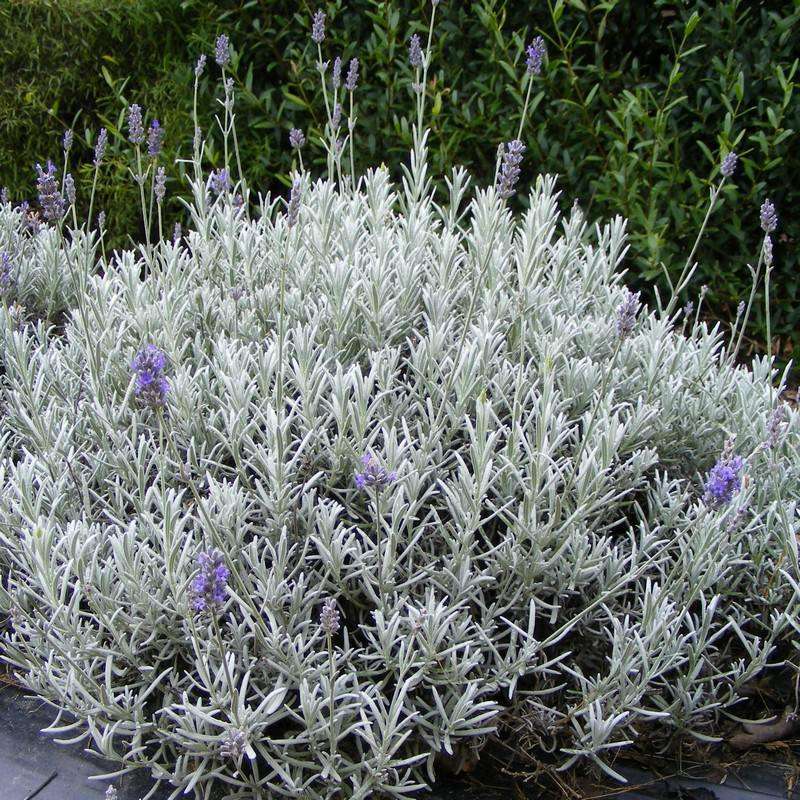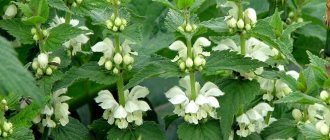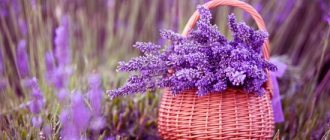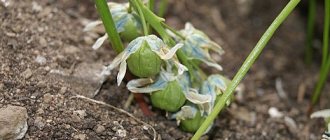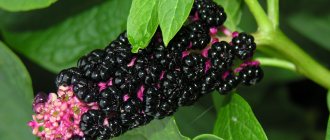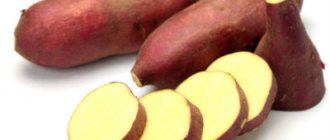In the south of Europe there are whole plantations of lavender, grown mainly for cosmetic purposes. Narrow-leaved lavender (Lavandula angustifolia), which is also called English - the plant is frost-resistant and unpretentious, grows with pleasure on poor soils. Therefore, today it is increasingly possible to find it in our summer cottages. In this article I will tell you what you need to carry out the autumn care for lavender. I will also share my experience of lavender breeding in the fall.
Lavender in the fall - care and reproduction
Lavender shelter for the winter
Experts count 39 types of lavender and its varieties. Among medium-latitude amateur gardeners, English narrow-leaved varieties are popular. They grow well in sunny, open areas and prefer light, well-drained soils. The southern beauty absolutely does not tolerate wet soil and shade. You also need to make sure that the plant is sheltered from the winds that will blow in the winter. Let's consider in more detail what other measures are needed to protect it.
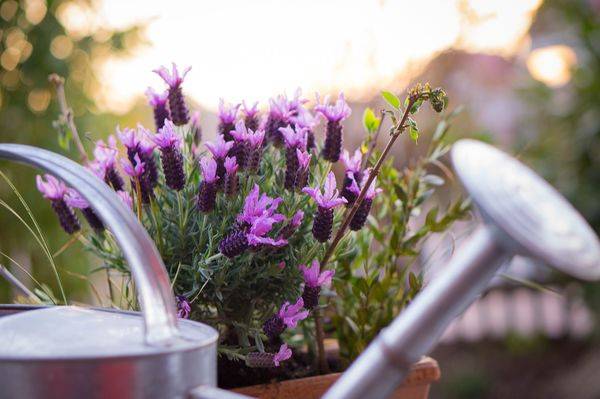
Why you need to cover lavender for the winter
Many gardeners note that narrow-leaved lavender does not freeze without shelter and can withstand frosts down to -25 ° C. It all depends on the climatic conditions, the amount of snow cap on the bushes. Residents of the southern regions of Russia can do without shelter, only be content with an abundance of snow and a cold winter. And the population of northern latitudes at the end of autumn begins to prepare lavender for winter.
The procedure for preliminary pruning of the bush is necessary, since long shoots freeze out significantly and break due to cold winds and sudden temperature fluctuations. By cutting off long branches, you can prevent possible diseases of the shrub and provide it with a favorable wintering. Such a planned sanitary procedure for pruning shoots is carried out in late summer - early autumn for the convenience of shelter. If it was not carried out for some reason, it is better to leave this venture until spring.
Lavender is sensitive to sudden changes in temperature, which are common in early spring. She does not tolerate stagnant moisture. Therefore, it is required to cover and insulate the plant from the winter cold.
How to cover lavender
To properly prepare the southern beauty for the winter cold, you must:
- Tie the bushes with twine to prevent snow from getting inside.
- Cover the area around the bush with a thick layer of dry peat, needles and sawdust (mulch).
- Tie the lavender and build a hut of spruce branches on top. Fasten tightly with twine so that the structure does not break from the wind. This will trap heat and provide good air circulation.
- Tied lavender can be covered with plywood boxes, additionally covered with snow. The abundance of snow will not allow the plant to freeze from the cold.
Mulch should not include fallen dry leaves, because under them the earth will rot and the roots of the flower will rot, and this absolutely cannot be done. Lavender, as mentioned earlier, does not like dampness.
If the bushes do not grow in open ground, but in containers, then you cannot leave them in the cold. The root system will freeze and the plant will simply die. Better to clean in closed unheated rooms.If the plant has sprouted during the winter, then it is advisable to cut off all growths before the beginning of spring. Only then take the flower pot out to a sunny warm place.
These measures are quite enough for a comfortable wintering of narrow-leaved lavender, which is most often grown in a country house in mid-latitudes. In the southern regions, it does well without additional measures to protect against the winter cold.
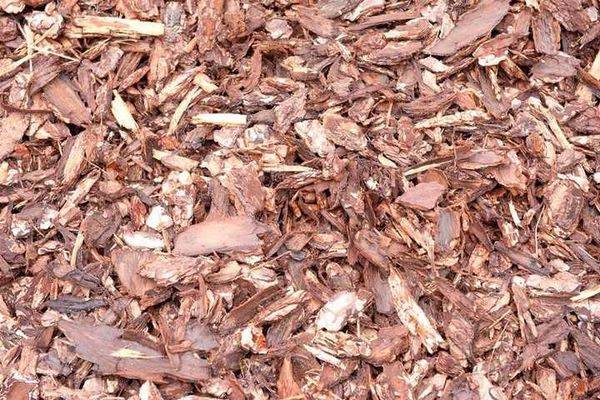

Suitable covering materials
Suitable materials for sheltering a bush from winter cold are:
- spruce branches;
- pine needles or pine branches;
- plywood or wood boxes;
- peat organic mulch;
- lutrasil or agrospan - covering materials for plant protection.
From time to time, it is necessary to correct spruce branches and mulch, scattered by the wind, to throw snow under the bushes. This is enough to keep the fragrant, beautiful plant from freezing in winter.
Competent planting
Before you start preparing lavender for wintering, it is important to plant it in accordance with all the rules. The landing process is an extremely responsible event. It is worth noting that an adult plant reacts negatively to a transplant, so it should be carried out only for good reasons. Determine at once the places where lavender will grow.
How to determine the distance between bushes? Maintain a gap that roughly corresponds to the height of the plant. In this case, the lavender will grow lush and attractive. If you want to see the planting in the form of a slender hedge, then this distance should be reduced several times.
If reproduction takes place by cuttings, then planting will not be difficult, plants take root very quickly. The whole process is so simple that even a beginner can handle it. The plant must be deepened, covered with soil to the desired level, covered with a film and periodically moistened. When the cuttings are well rooted, they can be carefully dug up and transplanted to a permanent place of growth.
If the planting went according to plan and the plant began to develop quickly and well, you can be sure that in the fall it will already get stronger and it will be possible to prepare it for the first wintering. Proper planting will ensure that the plant will successfully overwinter and continue its development in the spring. But for further growth, it is very important to prepare the plant before sheltering for the winter.
Features of preparing lavender for winter in the regions
The shelter of lavender in the middle lane and other regions of Russia has its own nuances. Each area has its own distinctive features that define its unique appearance. How to prepare a plant for winter, given the climatic conditions in the regions, is a key issue that should be considered in more detail.
In the middle lane
Winter weather in central Russia is changeable, with sharp temperature changes and frequent frosts. In January, the thermometer can drop to 30 ° C below zero. Winter is not always accompanied by heavy snowfall. If there is no white blanket, it is strongly advised to cover plantings for the winter. After all, southern lavender is most susceptible to freezing.
The plant should be tightly tied with a rope and covered with spruce branches. Sprinkle the trunk of the bushes with organic mulch. Such measures to protect the landing will be sufficient.
In the Urals and Siberia
In winter, the Atlantic air manages to cool down very much before reaching Siberia and the Urals. In winter, temperatures reach 30–35 ° C below zero. The southern bush must be insulated: tie it with twine and cover with burlap or agrospan. Sprinkle spruce branches on top or build a pine hut.
In the Volga region
The climate of the Volga region is characterized by warm summers and moderately cold winters. Winters are quite long, lasting from late November to early April. Frosts can reach -30 ° C, but this is rare. The average air temperature in winter is -14 ° C.In February, the snow cover reaches its maximum.
Ideal conditions for wintering a fragrant southern plant. You don't have to cover, mulching will be enough. The only condition is to tie the bush with a rope and, if necessary, correct the mulch and throw in snow.
Use in landscape design
A riot of colors of blooming lavender will adorn even the most unattractive summer cottage. Alpine hills, rocky gardens - places where lavender is more often planted. Lawns planted with blue flowers look well-groomed and luxurious.
Flowerbeds, vases with lavender, paths in the garden, along which various shades of purple flowers, look gorgeous. The lavender bushes are also great.
Lavender flowers look no less elegant in combination with other plants, for example, with roses, hydrangeas. In addition to beauty, lavender protects neighbors from insidious insects with its fragrance.
The contrast of lilac colors with white, red, yellow flowers gives the site an elegant, festive look. Planting and growing lavender in the Urals is no more difficult than in another region.
Lavender is a fairly hardy plant, but it often suffers from weather conditions with improper care. This is especially true for the cold season. Therefore, many gardeners have a question, is it necessary to cover lavender for the winter and how to do it correctly.
Features of lavender care in autumn
Lavender is a capricious plant, so that it does not suffer from the effects of low temperatures, it is necessary to create the necessary conditions. Warm regions are perfect for her, therefore, in areas with a harsh one, before wintering, you must:
- loosen the soil around the bushes;
- remove weeds thoroughly;
- cut the flower;
- apply mineral fertilizers for feeding;
- cover thoroughly for the winter.
For the active growth of lavender, it is necessary that the roots are unimpededly fed by the incoming oxygen. For this, loosening of the soil is carried out. If the soil is dense, the procedure is carried out regularly throughout the season, and the roots of the weeds should be removed. So that they do not germinate again, you can fill the soil around the bushes with mulch from fallen leaves. To make the shrubs look attractive, the leaves are replaced with decorative substrates, they are also useful.
The issue of watering is also relevant. The plant does not tolerate swampy soil. The amount of water should be moderate. Otherwise, the leaves of the flower begin to rot and turn yellow. With insufficient watering, it gradually dries up. It is better to irrigate the area as it dries. Before wintering, lavender can be fed with potassium, phosphorus. The main feeding is done in the spring. Fertilization can be abandoned if a special decorative substrate is laid out around the bushes. In the process of its decomposition, mineral fertilizers will enter the soil, nourishing the root system of the plant.
Diseases and pests
The most dangerous disease for lavender is gray rot. She starts up from waterlogging. This is why it is so important to regulate the watering of your plants. Diseased flowers will have to be destroyed, and the remaining ones will have to be treated with fungicidal agents.
Insects that can harm lavender bushes: rainbow beetle, aphid, penny. The beetle eats foliage, it is often harvested by hand. Due to the penny, the plant is covered with white foam. In this case, the bush is washed with warm water. For insect pests, the plant is sprayed with a product such as Actellik. The strong scent of the lavender bush repels harmful insects, which many of the parasites cannot tolerate.
Pruning lavender in the fall
Gardeners prune throughout the season and the flowering period of the plant. This must be done so that the buds that have already bloomed are replaced with new ones. It is necessary to carry out manipulation in the autumn.There are a number of explanations for this, but the main task is to preserve the shrub for a long period.


Do I need to prune lavender in the fall
Timely pruning before winter is essential. The procedure allows you to keep the plant compact. Not all gardeners remove ground shoots, explaining this by the desire to maintain the shape of the crown. After the snow falls, the plant will be densely covered on top and will not freeze even at low temperatures.
In regions where the amount of precipitation can be minimal, ground shoots can freeze out due to wind and frost. When freezing, the trunks become brittle and easily damaged. The risk of developing plant diseases in the broken parts increases. They can also be damaged by insects.
When to prune lavender in fall or spring
Planting lavender and outdoor care involves pruning from the first spring months. The procedure is necessary to accelerate the onset of flowering. In addition, this way the shrub can be given the desired shape. This work in the garden can be carried out as soon as the risk of frost has disappeared and a constant temperature has been established.
Pruning can be drastic. In this case, a secateurs remove one third or half of the total volume of the shrub. This is permissible if the procedure was not carried out in the fall. It is also necessary and sanitary removal of trunks that have suffered from frost and pests. In the fall, you should carefully remove all shoots that have faded. Considering all the nuances, there is no definite answer when it is better to prune: in autumn or spring. It is important throughout the season.
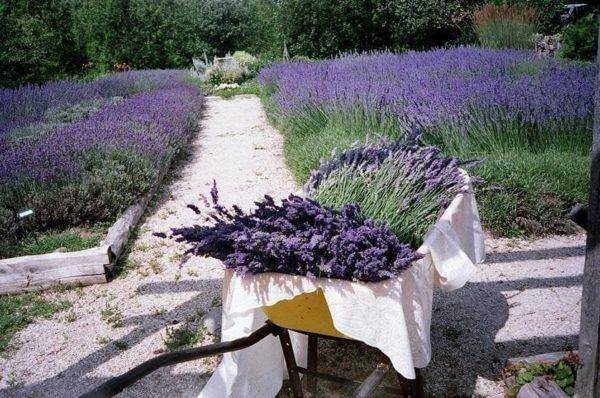

When and how to prune lavender in the fall
You can start pruning in the fall when the second flowering period of the plant has ended. Most of the time this happens in September. Excess growth is removed so that it is more convenient to cover the shrub for the winter. It is necessary to leave the upper part 3 cm high. This will allow the plant to calmly endure the cold season and not suffer from subzero temperatures.
Circumcision is performed in 2 stages. First, you should remove the growth to the middle of the height. Then rejuvenating pruning is done. The second part of the barrel is removed so that the desired height remains. So, the plant will not suffer, it will overwinter well.
What does lavender look like and where does it grow?
Lavender - shrub plant, the height of which is usually 60–90 cm. There are dwarf species not exceeding 30 cm. Numerous shoots extending from the root, slightly stiff at the bottom. They have narrow leaves of a lanceolate shape with a length of 2 to 6 cm. Their color depends on the species: it can be green or bluish due to gray pubescence.
But the main wealth of the plant is its fragrant lilac flowers, collected in "spikelets", swaying on thin numerous stems. This is a "traditional" coloration, although there are varieties with white and pink coloration. Hybrid varieties with an unusual appearance have been developed, for example, "Willow Vale".
The historical homeland of lavender is the Mediterranean region and the Indian subcontinent. It also grows in Arabia, Australia, the east coast of Africa and the Canary Islands. As a horticultural and industrial culture, the shrub is grown all over the planet. A valuable essential oil is made from it, and dried leaves and flowers are used to fight moths and flavor things by putting bags of plant materials in the closet. The aromatic plant is also used in medicine - its aroma soothes the nerves.
Top dressing lavender after pruning
After pruning the lavender, be sure to feed it. For the procedure, you can use any fertilizer that is sold in specialized flower shops. Fertilizer is diluted with water (2 tablespoons per 10 liters). Before feeding, the soil must be well loosened and watered. If the fertilizer is poured onto dry, untreated soil, the lavender root system will break down and burn.
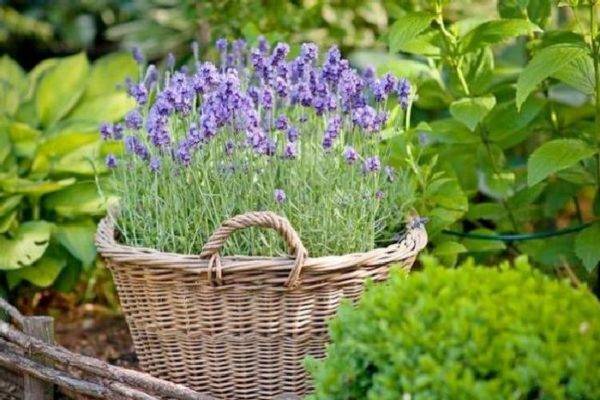

Appearance
What is culture? Lavender has excellent decorative qualities.On the branches of the semi-shrub, narrow leaves grow, the length of which does not exceed 5 cm. From above, they are covered with silvery hairs. The inflorescences have a soft purple color. Lavender begins to bloom at the end of June and pleases the eye of gardeners until mid-August.
The plant retains its amazing aroma even when dry and processed. Therefore, the French became interested in this plant. Today, you can find many cosmetic products with a lavender scent. Many well-known perfume companies use the oil of this plant to create fragrances.
How to preserve lavender in winter
Lavender grown in warm areas does not need to be protected from the cold. This is a frost-resistant plant that tolerates temperatures down to -25 degrees. In regions with dry climates, it must be covered. If lavender is grown in pots, then at the first cold snaps it is transferred to a warm place, protected from cold drafts.
The most dangerous season for a flower is spring, with its sharp temperature changes - it is warm during the day, and the thermometer readings drop significantly at night. Snowy winters are considered a safer period.
When can the cover be removed
The shelter is removed even when there is complete confidence that the frost has passed. Most often this is the end of March - beginning of April. Accordingly, it is not worth opening the bushes in early spring, since daytime warming during this period is usually replaced by sharp night frosts. This leads to freezing of the soil and the formation of ice, due to which most of the plants die in the absence of shelter during this period.
Important! Many gardeners and summer residents believe that not so much winter cold as spring temperature drops are terrible. Only having the right cover will save lavender from such strength tests.
How to cover lavender for the winter
Protecting lavender from winter cold snaps is not so difficult if you follow a few simple recommendations.
- Snow should not fall inside the crown, so it is good to tie the bushes.
- The soil circle must be well insulated. It is not recommended to use ordinary fallen leaves, since harmful microorganisms, fungi that can harm lavender are formed during their discussion. Dry peat and pine needles are excellent for this purpose.
- The entire bush must be covered with branches of spruce or other conifers. It is imperative to fix the hut with a twine. The bush can be slightly dug in with earth. The spruce hut is abundantly covered with snow from above. If the snow has not fallen, the plant is unlikely to be able to withstand the frost.
If lavender is grown in northern regions, plywood boxes can be used for shelter. On top of them, you need to put a large number of spruce branches - this is necessary for better oxygen circulation, preservation of heat.
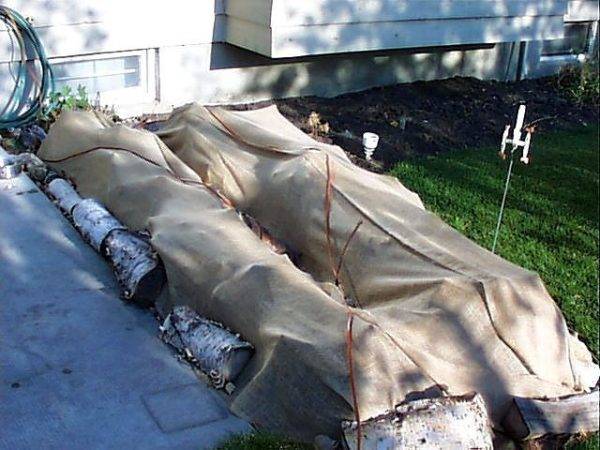

What materials can be covered
If we talk about covering materials, then it is better to give preference to natural or close to them options. But in gardening stores there are also special options that allow you to cover the bush without provoking unwanted effects. Mainly used:
- Sackcloth;
- Wooden or plywood boxes;
- Covering materials such as agrospan or lutrasil;
- Pine needles, twigs or peat soil mulch;
- Lapnik.
Having built a shelter, you need to correct it from time to time, especially if there are strong winds. It is also necessary to throw in snow, if any.
Shelter of lavender for the winter in the regions
Each region prepares lavender for wintering differently. This is due to climatic conditions - in some cities, winter is accompanied by an abundance of snow, winds, in others there may be no snow, the air is too dry and cold. To preserve the plant, it is important to take into account every nuance, otherwise, with the first frost, the flower will die.
In the middle lane (Moscow region)
This region is distinguished by the presence of severe frosts, however, most gardeners of the Moscow region prefer not to cover the plant for the winter. Autumn pruning is also not carried out - long trunks when tying, further falling asleep with snow, unlike other shelters, warm them better, protecting from the cold.
Broad-leaved lavender must be insulated with straw, hay, branches or peat. If the plant is grown in pots, it is removed to a warm room. If this is not done, they will die during the first frost.
In the Volga region
In this region, winters are accompanied by severe frosts. The temperature can drop below -25 degrees. Such weather conditions are prolonged, usually observed for two or more weeks. If the cold temperature is not accompanied by a large snow cover, all the seedlings will freeze. Therefore, lavender must be covered, providing it with good protection.
In the Urals and Siberia
These regions are characterized by severe winter cold snaps, the temperature here drops to below 35 degrees. Only narrow-leaved lavender (frost-resistant variety) is able to withstand such weather conditions. Pruning the plant is not recommended. Only a tall shrub is able to withstand frost, while retaining its root system.
In the Urals and Siberia, lavender shelter is mandatory. To do this, use all available methods. Suitable:
- sackcloth;
- agrofiber;
- spruce branches;
- spruce branches.
Only good insulation will allow the plant to survive the winter and in the spring it will start to delight with rapid growth, flowering and an unforgettable smell.
Types and varieties of lavender
Lavender is a genus of perennial plants that includes about 25 species. Some of them grow wild, but some have become real "hits" of landscape design. Mountain lavender, as a separate botanical species that has become popular thanks to the song of the same name, does not exist. But there are many others.
Lavender broadleaf (French)
Broad-leaved lavender became the basis for breeding varieties with high decorativeness, long bracts and variable color. There are burgundy, white, pink hybrids... The scent of the French variety is less pleasant than that of the English, but also pronounced.
We also recommend reading:
16 of the most popular indoor plants Physalis: description of species and varieties, technology of growing from spruce seeds in landscape design: the best decorative varieties and features of growing Kalanchoe: description of types and features of care at home
The advantage of the shrub is the early onset of flowering, which occurs already in May and lasts in July. Under good conditions, it repeats by the beginning of autumn. But French lavender cannot boast of frost resistance: in the Urals, it can be grown only in containers and flowerpots, which are removed indoors for the winter.
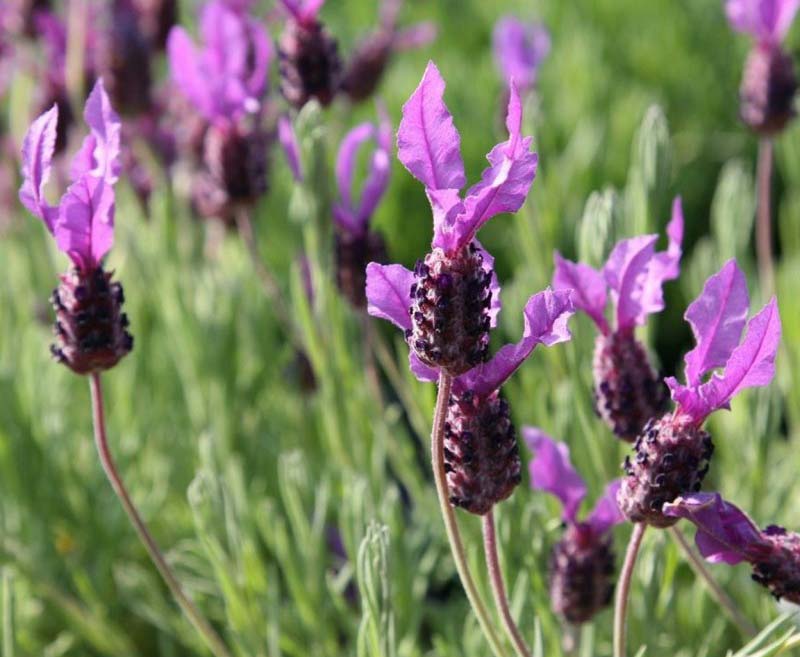

Lavender broadleaf (French)
Narrow-leaved lavender (English)
This species is also called "True lavender". It is unpretentious and tolerates a cold climate well, but in case of severe frosts, it needs to be covered. The bush grows up to 1 m in height and blooms from June or July. Popular with gardeners and landscape designers - not only due to the "classic" appearance for lavender, but also due to the pleasant, delicate scent. Breeders have developed many varieties on its basis: among them "Provence" and "Yuzhanka".
Wintering of potted species
More and more flower growers plant lavender in pots and grow it for landscape decoration, use it in design to decorate terraces and balconies. An ornamental plant, with proper care, overwinters well. During the preparation for the cold weather, you should cut it off, enrich the soil with the necessary amount of mineral fertilizers. The potted plant should not be left outdoors for the winter. It will not withstand the effects of low temperatures, even if a shelter is created. The flowerpots are best placed in a warm, heated room until spring.
Nuances of plant care in the Urals
There are no peculiarities in caring for the Ural lavender. A properly chosen planting site, prepared soil is a guarantee of healthy, beautiful flowers with lush flowering. The care is standard.
Watering and feeding
Drought lavender is less dangerous than waterlogging. Water the dry soil (no more than 5 liters per bush) once every 15 days. When the plant has faded, watering is completely stopped.
The bushes are fed with mineral fertilizers. Organic (peat, manure, humus) are introduced at planting. For the first time, the seedlings are fed with urea (1 tablespoon per bucket of water). The second dressing is carried out when lavender blooms, for example, "Agricola".
A wide range of products for feeding lavender in specialized stores. How to use them is indicated on the package.
Pruning and preparing for winter
In the Ural climate, spring pruning of lavender is carried out:
- First, dried branches are removed, then sick, damaged ones.
- On each bush, no more than 6 regrown shoots are left.
In autumn, the plant is not disturbed by pruning so that it has time to prepare for wintering. Due to spring pruning, the bushes rejuvenate, look neat, bloom magnificently. To avoid freezing in winter, caring gardeners do not do without sheltering the plants. The plantings are covered with agrofibre, burlap, any non-woven material, even spruce branches.
In no case should lavender be covered with compost or fallen leaves. They overmoisten the soil, the plant will rot and rot... One of the measures to prevent freezing in the Urals is growing in pots and flowerpots, which, with the onset of cold weather, are brought into the room, leave the plant alone, and occasionally watered.
Planting lavender in the fall
In regions with a warm climate, the flower is boldly planted in the fall. In winter, the temperature does not drop to critical values and the plant will not die. It is better to transplant a shrub to residents of the middle lane in the spring. You should first select a site. Lavender will not grow in wetlands. She also needs constant sunlight.
There is not always a suitable site in the garden, then it is better to create the required conditions artificially. To dry the soil a little, create an elevation, make a depression and first fill it with drainage, expanded clay, then cover it with earth and plant flowers. During the autumn planting you need:
- create an elevation of 40 cm in the selected place;
- prepare pits for flowers 25 cm deep;
- place them at a distance of 40 cm from each other;
- 60 minutes before planting in the ground, lower the roots of the plants into the water;
- cut off the tops;
- during planting, additionally add mineral fertilizers to the soil.
If lavender is planted correctly, it hibernates without problems. It takes about 2 months for the plant to fully root. The flower can be propagated by dividing the mother bush. It should be dug out, divided using a knife. All sections must be treated with an antiseptic: charcoal, crushed activated carbon, foundation powder. This will prevent the development of flower diseases, decay of the root system.
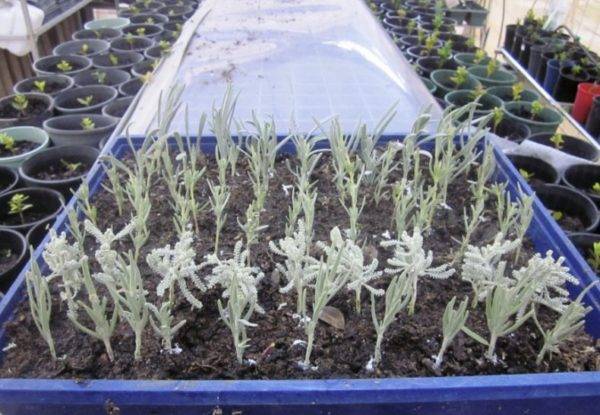

Planting methods
It is necessary to plant flowers in pre-prepared holes. Their depth differs depending on the type of plant. An indicator of 25-30 cm is considered optimal. Single plants can be planted or groups of them can be formed. In this case, a distance of 40 cm should be left between the formed bushes. To make the row look thick, this indicator is on average reduced by 2 times. Experienced gardeners prefer to form group plantings. With their help, it is easy to arrange a decorative border, to make a carpet planting. Flowers grow well in high beds, in pots or flowerpots used for the design of the site, balcony.
Optimal planting time
Planting plants is best in the spring. It is considered optimal for this. You should wait until the frosts completely stop, warm weather sets in.Residents of young regions can do such work in September, October. The climate is perfect. Before the planned cold snap, the first frost should be at least 2 months.
Plant soil
The flower will not grow in swampy, heavy soil. Stagnation of moisture is unacceptable for him. Rotting of the root system immediately begins. A sandy loam, gravel well-drained area is suitable for it. At the same time, the land should not be overwhelmed with nutrients or suffer from a lack of them. In some cases, gardeners independently prepare soil mixtures, filling them in the pits prepared for planting with them. For optimal composition, mix:
- leafy ground;
- humus;
- sand.
Landing place
To plant a flower, you should choose a well-lit, hot area in the garden. This will contribute to the lush flowering of lavender, the active spread of the characteristic aroma. If a shady area is chosen as the planting site, the plant will rarely bloom, single buds can be observed.
The soil must be dry. Excess moisture negatively affects the growth and development of the plant. If necessary, the elevation is best done artificially. An alpine slide is ideal for planting.
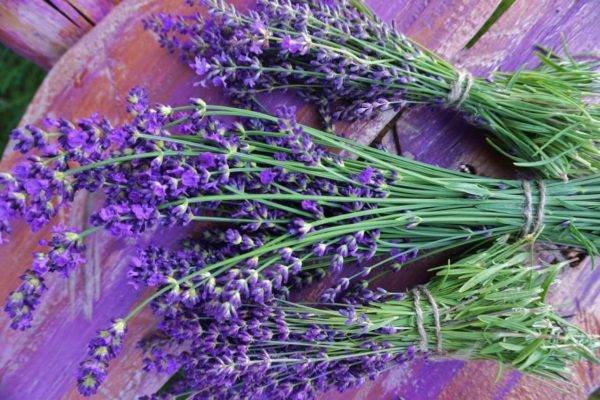

Shrub propagation
Lavender is bred using cuttings, layering, seeds, dividing bushes.
Seeds
In the Urals, seed reproduction is the best option. Seed material is protected in a place where it is dark and cool. Seeds remain viable for a long time. The main condition is the tightness of the package.
Before sowing, the seeds are hardened, that is, they prepare the future plant for cold weather, strong winds. Already at this stage of cultivation, lavender is prepared for the harsh climate. As gardeners of the Urals note, flowers grown from seeds are more viable than those planted with seedlings.
Cuttings
In this way, the bush is propagated at any time:
- In an adult plant, a stiff shoot is cut off - a stalk. He is planted in a pot of earth.
- The bowl is covered with polyethylene, which is removed every day and the plant is aired.
- The soil is sprayed with water as it dries.
After 50-60 days, the cutting will take root and begin to grow foliage.
Layers
An adult shoot is bent to the ground, fastened with a metal bracket, and sprinkled with earth in this place. Where the shoot was attached, the next spring it will take root. It is cut off and planted in the right place.
By dividing the bush
The breeding method is possible where lavender bushes are already growing. In summer, it grows overgrown with young shoots. First, fresh shoots are cut off by at least 10 cm. They are covered with earth so that there is no free space between the stems. In the middle of autumn, the bushes are dug up and separated with a shovel. They are planted where required.
Transplanting lavender in autumn
It is necessary to dig out the bush carefully, without damaging its root system. It is important that a large clod of soil remains on it - this will help protect the roots from damage. It is recommended to transplant in late summer, early autumn, when the flowering period ends. Transplanting lavender in the fall is required if:
- there is no shrub growth;
- you need to change the place of growth of the plant;
- dividing one large bush into several small ones is required.
The root system of lavender, despite the small size of the plant, can penetrate 4 meters deep into the soil. But this is not a hindrance during transplantation, since the bush easily tolerates such a procedure.
How to choose a variety
The variety of lavender species allows you to find exactly the variety that will grow without problems in the Urals, where the climate is difficult for a southern plant. Sharp continental changes from heat to frost, cold winters, windy weather - that brings many "surprises" for summer residents.
Considering that lavender are perennials, for cultivation in open ground, special attention must be paid to a strong root system, stability in growth, and flowering period. According to breeders, several varieties are suitable for growing in the Ural conditions.
- English narrow-leaved, withstanding frosty winters. These are low shrubs with dark lilac inflorescences, forming ears, with a light downy on the leaves. The peak of flowering occurs at the end of July, August.
- Manstida with pronounced blue shades, resistant to windy weather.
- Hittsot Blue, Khiant are distinguished by their short stature, density, in appearance they resemble small shrubs.
- Alba with white inflorescences for those who prefer a variety of colors.
- Beachwood Blue with delicate lilac flowers, attractive by the unique beauty of the blue range.
- Rosea is suitable for lovers of pink tones.
For indoor use, it is better to choose annuals as a houseplant. They bloom in the summer. A variety of winter-hardy varieties gives gardeners the opportunity to enjoy the beauty of shades, create landscape compositions, and include in the flora for alpine slides and flower beds.
Mistakes of novice florists
Due to ignorance of the rules for caring for a plant, mistakes can be made that, as a result, will lead to the death of a shrub or slow down its growth. In order to prevent this and enjoy beautiful flowering, you should not:
- water abundantly and cut the flower vigorously. Excess moisture will lead to damping of the horses, and deep pruning will not allow the plant to fully recover;
- plant lavender in clogged soil, where there is a lot of clay, peat. In such soil, the roots will not be able to receive the amount of oxygen necessary for growth and full development;
- prune quickly in spring. It is not necessary to actively cut off the bushes immediately after the snow melts, freeing them from excess and dry tops. The flower wakes up for a long time, you need to bring it into its proper form later, with the onset of heat;
- covering a flower with polyethylene is a gross mistake that leads to rotting of the plant. By spring, most of the flowers will be completely lost.
If you exclude these common mistakes, lavender will tolerate cold well, please with a lush color and will not be a hassle to care for.
Mistakes that gardeners make
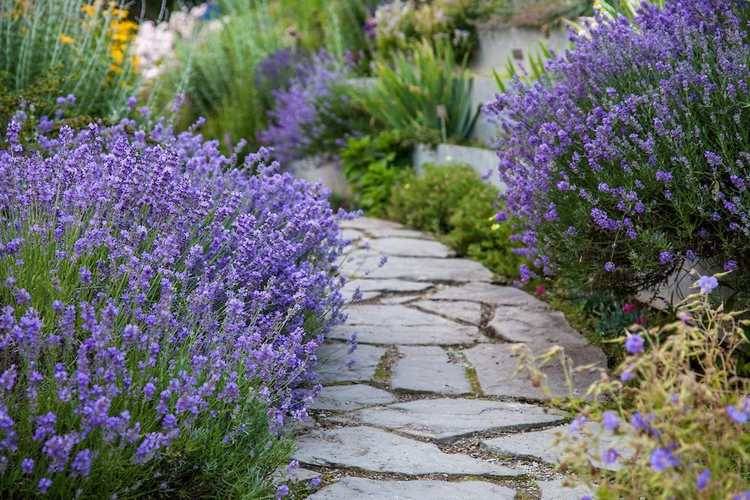

Even experienced gardeners often make typical mistakes that will undoubtedly lead to the death of the plant. Unfortunately, not everyone knows how to prepare lavender for wintering. Any, even the slightest mistake, will lead to irreversible consequences and instead of a beautiful perennial bush, in the spring you will receive a dead plant. The most common mistakes are:
- Too abundant watering and too deep pruning of the shrub. The roots of the plant begin to rot as a result of too frequent or excessive watering. Pruning too deep means that the lavender simply does not have time to recover by the desired period.
- Clogged soil with a high content of peat or clay leads to the fact that the roots do not receive the required amount of oxygen.
- Gardeners quickly prune or tear off dried tops - you should not do this.
- Shelter with plastic sheeting is unacceptable. Such a greenhouse will certainly lead to rotting of the bush.
Lavender, preparation for winter, pruning - all these manipulations are mainly designed for the English variety, which has another name - narrow-leaved. French lavender does not hibernate at all. It is better not to plant this variety for wintering, especially in regions with a harsh climate. In any case, competent autumn preparation will ensure the further healthy and correct development of the shrub. Cold-resistant varieties tolerate the winters of our country well, and if they are additionally prepared for frost, the plant will remain as strong and healthy as in the autumn season.
Tips for florists
The main problem that growers face is the weak frost resistance of the shrub. In the open ground, only narrow-leaved lavender can easily take root, and only when preparing a shelter for it. Ordinary dead leaves are not used for this. They can contain pests, pathogenic microflora and fungi develop. Overwintering under leaves will have a detrimental effect on the plant. For this purpose, it is better to use coniferous spruce branches. They cover not only the plant, but also the root circle.
If lavender does not bloom, then the place for its cultivation is not chosen correctly - it is too shaded. Also, the lack of growth can be a sign of overfeeding with nitrogen fertilizers. For good growth, it is important to loosen the soil, destroy weeds. Proper watering, timely pruning, feeding and preparation for wintering have a beneficial effect on the development of lavender.


Features of growing a plant in this region
The Ural climate is not characterized by mildness and warmth: harsh, with cold long winters, prickly winds, and severe frosts. Although in the southern Urals the weather is slightly milder than in the northern. Viable plants can withstand such conditions. Therefore, a variety of English lavender with narrow leaves is more often planted in this area.
Choosing a landing site
To plant perennial lavender in the Urals, it is necessary to take into account the requirements for the place, since its choice is a guarantee of successful growth and luxurious flowering of the bush:
- Should be well lit and sunny.
- Where there are no drafts and no wind blowing.
- The place is chosen high, dry.
Soil selection
Lavender thrives on dry, sandy soils. It is not necessary for the land to be fertile, the main condition for preparing the soil is the absence of a number of groundwater and high humidity.
If, after all, the land is waterlogged, it is necessary to organize good drainage from crushed stone, expanded clay, pebbles. Also, the plant does not like acidic soil. Acidity is neutralized with ash or lime.
Planting process
The lavender bush is planted with both seeds and seedlings. Young seedlings are taken out into the street in the last month of spring (in May). When sub-zero temperatures on the soil are no longer scary:
- Dig holes no more than 35 cm deep. A layer of drainage is poured, then peat or humus.
- A seedling is placed in a hole, the roots are spread, and buried. The soil is compacted.
- After planting, the plants are watered.
The interval between the planting pits is at least 40 cm. Lavender is planted with seeds both in autumn and spring.
Before winter
In late September or early October in the Urals, lavender seeds are planted in open ground. First, the site is dug up with coarse river sand or fine gravel for better air exchange. The seeds are deepened by no more than 4 mm. The soil is slightly tamped from above. In dry weather, the area with crops is watered, but not much.
To prevent seeds from freezing in winter, more snow is poured onto the planting site... In early June, the first shoots should appear.
In the spring
If for some reason it did not work out to plant in the fall, do not despair. Before spring sowing seeds in open ground, they are hardened, that is, stratification is carried out.
To do this, in mid-March, the seed is mixed with sand and sent to the refrigerator:
- When it is warm outside, the night frosts pass, the seeds are sown in the ground.
- It is necessary to ensure that the earth does not dry out, this will lead to the death of young shoots.
- First, the area with crops is protected with a covering material (spunbond, agrotex), with the moisture-proof side facing up.
- Seedlings emerge in 21 days. When they get a little stronger, the covering material is removed.
Lavender care in autumn
Cooling and refreshing spicy scent leaves no one indifferent. Every gardener wants a decorative perennial to smell for a longer time. To do this, at the end of the summer cottage season, it is necessary to add top dressing and trim. In early September, when lavender blooms again, the culture is fertilized with potassium-phosphorus fertilizers (10 g each of phosphate rock and calcium nitrate per bucket of water).
When flowering is complete (late September):
- carry out partial pruning, for this they trim all peduncles;
- water the lavender in the fall as needed, since the plant does not tolerate waterlogging;
- to improve the air exchange of the roots, the soil around the bush is well loosened;
- the shrub is spud, stimulating the growth of young shoots (loose fertile soil is poured abundantly at the base of the lignified twigs);
- when it gets cold (1st decade of October), additional pruning is carried out - damaged and dried shoots are removed, the bush is partially thinned out (no more than 1/3);
- shortened shoots are tied with twine: a compact bush is less prone to freezing.
With regular autumn pruning, lavender twigs are only partially shortened to simplify winter shelter. Do not prune to woody stems, this will kill the plant. Leave 3-5 cm of green shoots. You can finally form a bush in the spring.
When and how to prune lavender
Why prune lavender
Most often, lavender is pruned several times per season for completely different purposes.
- If you want to do composition of dried flowersthen cutting down lavender is recommended at the beginning of floweringwhen the buds begin to open. It is in this form that lavender can stand dry all winter.
- If you want to brew tea, use as a seasoning (or prepare seeds for propagation), then you need to cut the lavender at the end of flowering (late June-early July).
What's more, by pruning after flowering, lavender will be able to bloom again in early fall (September).
If this is not the case, then it is possible that your variety is not prone to re-flowering or the plant does not have enough warmth (you live in a very cool region).
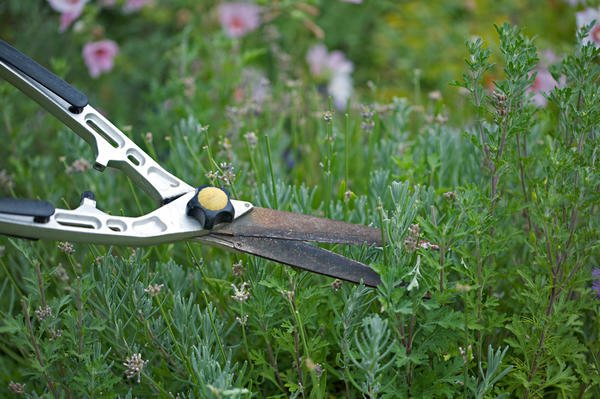

- In autumn, after re-flowering, the final formative pruning is done (at the end of September-October, the maximum is at the beginning of November).
By the way! In general, during re-flowering, you can again prepare twigs for dried flowers (before starting) or tea (at the end of flowering).
Video: how and when to prune lavender
How to prune lavender properly
So, as we have already found out, after flowering, it is recommended to cut off its peduncles from lavender.
Now let's figure out how to do it correctly:
- Naturally, pruning each flower is tedious and unproductive, so you need take many peduncles in an armful at once and cut off;
- Are subject to removal only peduncles, the bushes do not need to be pruned.
This can be done with a regular pruner or with large garden shears.
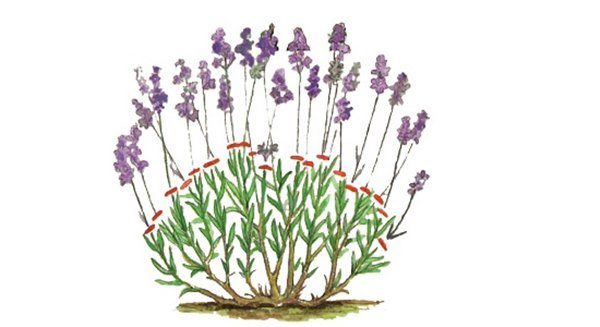

And already in autumn, after re-flowering, you can spend formation of bushes, i.e. downright cut the bushes themselves, bringing them to the desired shape (for example, a ball).
Some tips for pruning lavender in autumn:
- At this stage, you will need large garden shears.
- You can cut both very short and leave enough.
But in any case, you can only trim to lignified parts.
However, it is worth considering that the shorter you cut it, the later it will wake up in the spring; on the other hand, the tidier your bushes will be.
As a rule, lavender is pruned, leaving 15-20 cm to the ground.
- At the same time, it is highly desirable to completely get rid of the branches that lie on the groundby trimming them to a lignified part, as they will only spoil the appearance.
Video: pruning lavender in the fall
Preparing lavender for wintering
In regions with a mild climate (Krasnodar Territory, Rostov Region, Crimea, Caucasus), perennial bushes, as a rule, do not insulate. But experienced gardeners recommend that the first-year-old lavender be thoroughly mulched (with sawdust, pine litter) or a little burying its shoots with earth, and then protect it from the wind with an agrospan on a frame basis.
In the Chernozem and the Volga regions, a shelter in the form of a hut made of branches is made for lavender bushes and covered with a plywood box or any non-woven material for insulation. Sprinkle with snow on top. This is enough for wintering a thermophilic culture in a temperate climate.
In the North-West, the Urals, the Far East and Siberia, the harsh winter does not dispose lavender to winter without shelter, here the preparation of fragrant bushes for winter is a whole event. It is recommended to mulch the root space of the plant with small spruce branches, needles, any loose organic mulch. Then the bush is wrapped with burlap or agrospan (lutrasil), and a shelter of branches is built on top. To prevent the structure from collapsing from weathering and under the influence of precipitation, it is covered with non-woven materials. A dense snow cover will further increase the plant's chances of a successful wintering.
In the middle zone of the Russian Federation, English (narrow-leaved) lavender tolerates winter better. And the French (broadleaf) is in fact a pot culture, wintering only indoors at +5 C °, not lower. It differs from the English in denser purple-purple spicy inflorescences with noticeable petal tongues at the tip.
In the temperate climate of the Black Earth Region, I only insulate young (annual) lavender bushes. For this, I cover the plants loosely with pine branches, the rest will be done by the snow cover. It is better not to cover lavender with leaves and hay for the winter, so as not to provoke rotting of the bush. Adult plants can partially freeze out only in an open area (when the temperature drops to -20 C °). Flowerbeds with mature lavender bushes, located along the walls of buildings, winter well without shelter.
What materials should not be covered
Oddly enough, but there are materials of both artificial and natural origin, which are not suitable for sheltering lavender for the winter. These include:
- Artificial films;
- Polyethylene;
- Fallen leaves.
All these materials have one thing in common - they create a greenhouse effect, especially at the roots. And the latter also has a number of other disadvantages, such as a high probability of preserving harmful insects in the leaves, as well as various pathogens, including bacteria, viruses and parasites. In any case, such materials threaten not only diseases, but also root rot and the death of lavender.
Plant propagation
Lavender is relatively easy to propagate given the variety of methods available.
Reproduction methods
Lavender reproduces in almost every way that is used in horticulture:
- Seeds;
- By dividing the bush;
- Layers;
- Cuttings.
Seed reproduction
Lavender seeds germinate quite well, but only if stratified has been carried out. To do this, sow the seeds in a bowl with a wet mixture of sand and peat and put them in a basement, cellar or refrigerator for several months. The minimum period for stratification is 30-40 days. After that, the plants are brought to light and kept at a temperature of 15-21 ° C. After the formation of 3 leaves, the seedlings dive into pots of several pieces.
Need to know!
Some species, for example multi-cut lavender, germinate well without stratification.
Reproduction by dividing the bush
Mature, well-grown bushes can be divided into several parts. The bushes are dug out with a large clod of earth. The rhizome is cut with a garden knife into several pieces, each of which must have roots. Sections are treated with foundationol powder or crushed charcoal to avoid decay. Each piece is planted in a prepared pit.
This method is considered one of the most productive varietal plants for propagation. Narrow-leaved lavender, cuttings well in spring and autumn, and for broad-leaved lavender, autumn cuttings are preferable.
Autumn cuttings are more productive, since the plant has much more good shoots suitable for rooting. You can use cuttings from different parts of the stem:
- Apical;
- Average;
- Lower.
However, it is worth considering the characteristics of each type of cuttings. Completely lignified cuttings from the lower part of the stem take root very poorly, but withstand winter well.Apical cuttings form roots easily, but their winter hardiness is very low. The best option is semi-lignified cuttings from the middle part of the stem.
The stalk is cut with a sharp knife. At the bottom, all the leaves are removed. The cut is treated with root, heteroauxin, or any other drug that stimulates the formation of roots. Then the cutting is placed in moist soil and covered with foil. The greenhouse is ventilated daily to avoid the appearance of fungal infections.
Reproduction by layering
The best time for this breeding method is spring. A branch of the plant is pinned to the ground and lightly sprinkled with soil. The place of contact with the ground is regularly watered. As a rule, roots are formed by autumn and the young plant can be separated from the mother plant.
Growing lavender in a pot
It is quite possible to grow lavender at home. You just need to choose the right soil, a container for planting and observe comfortable conditions. Lavender loves space, so choose a spacious pot. It is best to choose oval or oblong containers. A pot with a diameter of 30 cm is suitable for planting a small plant. If you plant in a container, then its volume should be 2 - 3 liters. The pot should have many drainage holes to drain moisture away. It is best to pick up a vessel of light shades so that the earth does not dry out. It doesn't matter what the pot is made of, but experienced flower growers advise choosing from unfired ceramics. So the roots will not suffer from waterlogging.
Now you need to decide on a place. Lavender is a sun-loving plant, so it is better to put the container with the plant on the southern windows, and in the summer even on the balcony or in the garden. For additional lighting, you can use special phytolamps, or ordinary fluorescent ones. The daylight hours of lavender lasts ten hours. The next step is soil selection.
The plant requires a substrate including:
- sand;
- gravel;
- humus;
- sod land.
If you cannot prepare the soil yourself, then a ready-made mixture from a store is quite suitable. Next, we move on to planting lavender.
This can be done in several ways:
- sowing with seeds;
- layering;
- cuttings.
Growing from seeds was described above, so we will not repeat. For reproduction by layering, the extreme shoots at the bush are bent and fixed with staples. After the place of attachment with a staple to the ground, sprinkle and moisten. After the roots begin to form, and after a couple of months you can transplant the layers.
Planting by cuttings will allow you to get a plant that can bloom the next year. To do this, a one-year-old branch is cut off from the plant and divided into several parts. After that, they are planted in a container with sand and peat, watered and covered with caps. In this way, we create a greenhouse environment that favors germination. And of course, proper care, the guarantee of a beautiful plant. Lavender loves water and is watered so that the water first hits the leaves and then drips onto the soil. In hot weather, it is regularly sprayed to maintain moisture levels. In winter, watering is reduced to 1 time per month. the plant is resting. Lavender needs to be fed periodically, before the buds appear with nitrogen-containing complexes, after the buds are formed with phosphorus-potassium fertilizers. The plant must be pruned in spring and early autumn to form a spherical shape. Lavender needs to be transplanted into larger containers annually.
Description of lavender
What lavender looks like (pictured) in summer is known only to those gardeners who have already tried to breed this graceful plant.
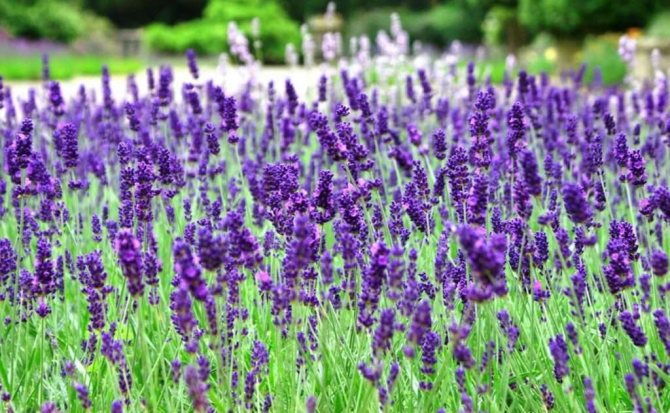

Only they know what the planting material should be, how to care for young shoots so that they take root. As it grows, lavender tends to stretch up to 60 cm in length, so it is heavily pruned to keep the flower beds neat. But the cut branches with flowers are not thrown away, but dried.Dry plant: leaves and flowers do not lose their medicinal properties, therefore it is added to infusions and decoctions.
Aromatic lavender oils are added not only to aroma lamps to create a pleasant microclimate in bedrooms, but also to bath water for treating colds and in a bath for diseases of the musculoskeletal system. Many cosmetics contain medicated essential oil supplements. Some species of flowers are used in cooking.
It's important to know! Lavender is a honey plant that attracts bees to the garden. And it is also able to protect other plants from some pests.


Among the variety of species and varieties, not only purple and blue, but also lilac, pink, greenish, white lavender pleases the eye. In addition to the main palette, spikelet inflorescences have even more shades.
Sowing lavender seeds
Lavender is difficult to propagate by seed. But if it is not possible to purchase an adult plant or twigs, you can also try sowing seeds.
Lavender can be propagated by seed. A very important step is stratification. Lavender seeds need to be kept at low temperatures for some time. Here you can go in two ways: plant them at the end of autumn immediately in the ground or carry out artificial stratification. The first method is only suitable for warm climates. With significant frosts, seeds may die. Therefore, it is better to opt for the second option.
For artificial stratification, the seeds must be mixed with a small amount of sand, poured into a container, wrapped in polyethylene and refrigerated. Keep them there for at least a month and a half. Better - longer. In this case, seedlings will appear faster. Then you can sow seeds in boxes (at the end of winter) or in
greenhouses
to the street (in late spring).
When sowing with seeds, it will take a whole year to expect flowering. In the first seasons, seedlings will only develop, increasing the root system. And only after a year, and maybe even after two, they will delight the gardener with pretty spikelets-inflorescences.
You can choose lavender seeds in our catalog, where products from various online stores are presented. Select lavender seeds
Lavender grown from seed will only flower for 2-3 years. Photo from the site
Soil processing near bushes
Lavender does not like dense soils. Its roots really need good air circulation. In addition, of course, you need to get rid of pest weeds next to lavender. Therefore, loosening and weeding should become a regular procedure.
You can do it easier - organize a good mulching layer on the lavender garden. As
mulch
you can use the decayed
foliage
or decorative multi-colored substrates. But in any case, near the base of the trunk, the soil should remain uncovered. This will keep the plant from rotting.
Water the lavender very carefully. Abundant irrigation can lead to root rot and yellowing of the aerial part of the plant. Drought is also bad for the plant - the lavender will not die, but the flowering will not be as luxurious as we would like. The ideal watering regime is as the soil dries up.
Cutting frequency
How often to prune lavender:
- The bushes of the first year of life are not pruned, giving them the opportunity to build up the root system, get stronger and stock up on a sufficient amount of vitality necessary in the future for abundant long flowering. To realize the same goal, experienced florists recommend removing single flowers that appear on first-year bushes.
- The first shearing of overwintered young plants is carried out in early spring, relieving them of broken and frozen stems. Subsequently, they should be trimmed annually: in spring and autumn. Well-done pruning, which is an essential part of lavender care, will contribute to the more luxuriant flowering of the bushes over the years.
- For the winter, only those plants that have bloomed for two seasons are pruned. Pruning should be done until mid-September, so that before the onset of cold weather the plant has time to give several new strong shoots (in this case, they will have enough time to lignify). If for some reason it was not possible to complete the autumn pruning within the specified time frame, it is advisable to postpone the procedure to spring. In both cases, dry inflorescences are removed along with young green shoots (lignified brown branches cannot be pruned).
Pruning features
Simple tips will help you to carry out the procedure effectively.
- In nature, lavender looks like an unkempt bush with a bare bottom. The main purpose of pruning is to give the plant an attractive appearance. Shortened specimens acquire a beautiful bushy shape, becoming more lush.
- When pruning for the winter, the lignified parts of lavender do not touch: they are prone to cracking if damaged and grow poorly. In herbaceous shoots, about 3 cm is left. This length reduces the risk of damage from strong wind or snow.
- When the seeds ripen, the plant spends a lot of energy, so the summer haircut is carried out before the ovary appears.
- To make lavender oil, flower shoots are cut during the day, immediately after the mass flowering. After a week, the concentration of the beneficial substance gradually decreases.
- It is appropriate to organize an extreme haircut on old plants in two stages. First, half of the shoots are strongly cut off at a height of about 8 cm. When new shoots wake up in the damaged areas, the second part of the plant is sheared. In very hot weather, there is a high risk that the lavender will not grow back, at this time the procedure is not carried out.
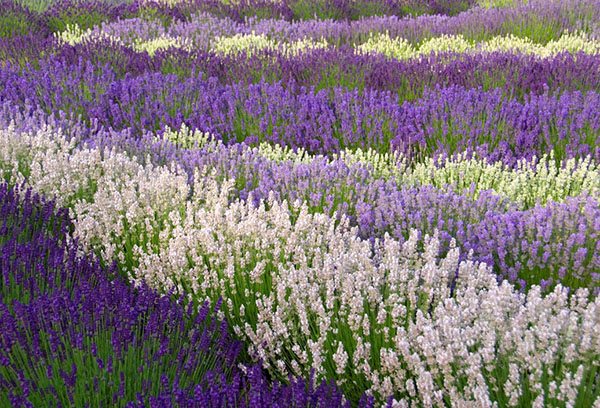

Pruning lavender bushes
This stage of lavender care cannot be called mandatory. But only by pruning can you achieve the formation of beautiful lush bushes. Therefore, you should not give up a useful procedure.
Pruning lavender The first pruning should be done immediately after the inflorescence spikelets wilt. You need to shorten the shoots literally by a couple of centimeters. At the end of the warm season, more drastic pruning is carried out. But here, too, you should not show excessive enthusiasm. If you shorten all the branches to the level of the lignified part, the bush may die.
Beneficial features
The trimmed parts of the plant are not thrown away. Lavender is widely used for cosmetic and medical purposes. Useful tea and tinctures are brewed from fragrant inflorescences, which are used to treat various diseases. Lavender oil is obtained from a spicy plant - a popular cosmetic product. Dried stems are used to form beautiful bouquets for interior decoration. Whimsical ikebana can be created on your own, they will delight with their appearance and recognizable spicy aroma.


How to plant seeds correctly
Step-by-step instructions for planting seeds will help gardeners grow a magnificent lavender bush with good exterior qualities and abundant flowering.
- Before sowing, the seeds are placed in the refrigerator for a month.
- The best option for a planting container is pots, containers with the addition of peat.
- The temperature range is about 20 degrees Celsius.
- The seeds are sown in the first days of March.
- The first three leaves dive, and if you need to avoid excessive bushiness, then pinch.
- Planting seedlings is best done in the second half of May.
- Shallow sowing of seeds (about 0.4 cm) is recommended, in case of expected frosts - additional shelter.
- The distance between the shoots is at least 25 cm.
- If necessary, thin out the grown plants.
A variant of winter sowing in the ground in a garden plot is possible, then the first shoots are expected at the end of April. It's risky. It is difficult to predict the weather conditions due to frost.
Plant pruning methods
So that the shrub does not lose its decorative qualities, it must be cut one or more times during the year.Too often this is also not worth doing, otherwise you can disrupt the flowering periods of the plant. There are several ways to trim:
- After flowering - under favorable conditions, lavender blooms 2 times: the first - in the middle of summer, and the second - in September. To stimulate re-flowering, the shrub needs pruning. When harvesting plant materials, the inflorescences are cut off at the beginning of the period, when they have just blossomed. If blooming lavender is needed for making bouquets, you can do this a little later, first enjoying the beauty of the plant in the garden.
- Sanitary - such pruning is carried out in the spring, removing broken, diseased and dried branches from the bushes.
- Autumn - pruning during this period is carried out to preserve the compactness and decorativeness of the bush, and also so that its branches do not break under the weight of snow and do not freeze in cold winters.
- Rejuvenating - if the bushes are already many years old, you can try to rejuvenate them by cutting off the shoots in the fall 5-10 cm from the surface of the earth.
Advice. In order not to accidentally destroy the plant, it is better not to cut off the entire bush at once. It is advisable to first cut off the branches of half of the bush. And when new shoots grow there next year, it will be possible to remove the old branches and the second half of the bush. But you need to be prepared for the fact that the old plant will not survive and will have to be replaced with a new one.
Typical care mistakes
In the process of growing lavender, there are typical mistakes:
- Shoots are trimmed at the root, considering that this is a herbaceous plant, and the methods are chosen the same. Only green shoots are pruned.
- Pour lavender. Due to excess moisture, the root rots, the bush dies.
- Choose an airtight shelter material such as polyethylene. The ground part undergoes heating, which leads to fungal infections.
- Inexperienced gardeners, without waiting for the growth of lavender, pull it out. This is a late awakening plant. It is not worth getting rid of the bushes ahead of time.
- Wrong ground. The flower loves breathable soil with an acidic reaction.
If the bush was not cut off in the fall, then it is tied. Snow will not be able to get into the central part of the flowers and thereby harm it by freezing. The plant in the bunch will keep better warmth.
Vegetative breeding methods for lavender
When planted by seed, lavender will only start blooming after 2-3 years. If you need to get flowers earlier, you can use vegetative propagation methods:
- Cuttings. At the beginning of summer, cuttings are cut with a length of 8-10 cm, then they are put on rooting in water or in soil of sand and peat. It is advisable to rooting cuttings in greenhouse conditions. In a month, the seedlings will be ready for planting in open ground.
- Layers. To obtain a new plant in spring, the lower branch is bent to the ground, pinned and buried. By the fall, the cuttings will take root, after which it can be separated along with the root and transplanted to the chosen place.
- Division of the bush. When basal growth is formed around the bush, it must be dug out in the fall, cut off from the main plant along with the roots and planted in the designated place.
Let's dwell on this in order to study the issue in more detail. Many novice florists interested in the possibility of growing lavender in the Moscow region are also worried about breeding methods. Is it possible? Yes, there are even several basic ways:
- Division of the bush. This method works well if you have mature plants at your disposal. To do this, in the spring, you should sprinkle the mother bush with earth in such a way as to separate the layers. In the fall, they can be planted in different places.
- Cuttings. A simple and convenient way. Cuttings 10 cm long should be cut from lignified shoots in the spring. After that, they are planted in a greenhouse in moist, loose soil. Young plants should be constantly ventilated and watered. In the fall, rooted cuttings can be transplanted to a permanent place.
- Layers.Another simple and effective way to propagate lavender. In the spring, it is necessary to bend the shoot, then bend it and sprinkle it a little with soil. By the fall, roots will grow in this place. After that, the layering can be simply cut off and transplanted to a new location.
- Seeds. This is the most difficult method for propagating lavender. Only experienced flower growers can do it. Seeds are usually sown in spring. A couple of months in advance, the seed must be placed in wet sand and kept in the cold. Seeds may not sprout without stratification. Lavender seeds can also be planted in open ground in the fall. Then, in winter, more snow will need to be thrown over this area. However, with such planting in northern latitudes, the seeds may well freeze out.
Propagation by cuttings is suitable if someone on the site already has a healthy lavender without signs of disease, when there is a need to preserve varietal characteristics.
- The stiff shoots are cut off.
- Stems with buds are selected and cuts are made: above (3 cm) and below (1 cm) them.
- Rooted in a container with sand, highly moisturized.
- Cover with foil, glass.
Additional methods: dividing the bush and layering. They are held in mid-May. The bush is pressed to the ground, deepening into pre-made furrows. They are fixed, covered with soil, constantly moisturizing. Exactly one year later, a new plant will grow in this place.
Landing place
The key to successful
growing lavender - the correct choice of landing site. Most of all, the plant will like open areas, well-lit by the sun's rays. The bushes will take root in the shade, but it will not be possible to achieve abundant and long flowering.
Plant roots are sensitive to high soil moisture levels. Therefore, you should refrain from planting lavender in wetlands and areas where they lie too high
groundwater
... If there is no other option, you can try to build a hill and plant bushes on it. Excess moisture near the roots can be easily removed with a drainage layer.
Any variety of lavender can be grown as a pot plant.
Lavender is also demanding about the level of acidity and soil structure. Therefore, if in doubt, it is better to play it safe - before boarding, deposit in
soil
a little woody
ash
or lime. These are effective soil deoxidizers. And to ensure the porous structure of the soil, it is enough to regularly apply to the garden
compost
... It will not only loosen the soil, but also supplement it with nutrients.
Let's summarize
- You can prune lavender in autumn in most regions of Russia, in Belarus, in the north and in the center of Ukraine. First, it allows you to comfortably cover the plant. Secondly, this procedure rejuvenates the bush.
- When pruning in autumn, do not touch lignified shoots. Also leave a small area (about 3 cm) of the green, young part of the twigs intact.
- To make the root system better overwinter, lightly feed the lavender with a mineral fertilizer containing potassium and phosphorus.
- Lavender's winter shelter differs depending on which region the flower grows in. If in the Moscow region it is possible to completely abandon the shelter, then in the Volga region there is no way without a spanbond, and in Siberia it may be necessary to knock down a "house" of plywood for a flower, and wrap spruce branches on top.
And when the snow melts in the spring, the bushes can be cut off again. How exactly to do this, the gardener will show:
Lavender is a beautiful Mediterranean plant that also adorns our gardens. In order for this southerner to delight you every year with its flowering and aroma, it is very important to properly care for the shrub after its flowering, as well as in the fall, while preparing the lavender for winter.
Fertilization
Great as a fertilizer for lavender
mineral
complexes that are sold in all garden and flower shops. They should be applied during the beginning of flowering. Concentration - 2 tbsp. spoons in a bucket of water.With the resulting solution, you need to shed soil around the perimeter of the bushes.
Responsible for the development of green mass
nitrogen fertilizers
(2 tablespoons per bucket). Therefore, they are indispensable at the beginning of the growing season (growth). But in the second half of the summer, it is prohibited to use them. Under the influence of nitrogen, the growing season is significantly extended. As a result, the plant does not have time to prepare for wintering.
The use of fertilizers can be completely abandoned if there is a thick layer of compost mulch under the bushes. Decomposing under the influence of external factors, it will supply the plant with nutrients throughout the season.
Using lavender
Lavender is grown today not only for its decorative qualities. This plant is great for flavoring drinks. It can also be used as a seasoning for meat and fish dishes. Lavender goes especially well with lamb.
Lavender essential oil deserves special attention. It has found active use for medical purposes. Lavender essential oil is used against insomnia, fatigue and to relieve anxiety. It can also be used as an ingredient in homemade soap.
Autumn pruning
Autumn pruning is an important and crucial moment. The procedure helps to preserve the decorative effect of the bush, prepares the plant for wintering. Lavender has a taproot that goes deep into the soil. Therefore, many varieties are resistant to frost. Spring temperature drops are terrible for the plant. The snow thaws and freezes again, creating a dense ice crust. Oxygen access is limited, the bushes die.
Bushes form in the second year of life.
- Sharp garden shears or pruning shears are treated with alcohol. This is important, otherwise the instrument will infect.
- They examine the bush and, first of all, free it from sick, dry, broken branches.
- The stems of lavender are lignified at the bottom, green at the top. Pruning is carried out 3 centimeters above the lignified part. Completely lignified shoots are not touched.
- The procedure is carried out after re-flowering. If the plant has not had time to bloom, young shoots are not cut off.
- The second case: late with pruning before the onset of cold weather. Plants may not have time to prepare for winter. Therefore, the shoots are not touched until spring. They are tied up, bent to the ground, covered with spruce branches.
In the Moscow region, the onset of autumn cold weather can be delayed or come unexpectedly. All actions are associated with climatic conditions in a particular season..
Time and way
During the growing season, lavender needs pruning.
Spring
In early spring, the shelter is removed from the lavender. Sanitary pruning is carried out. Remove frozen, rotten, dried shoots. If in the fall, for some reason, the formation of the bush was not carried out, this is corrected in the spring, according to the same principle as in the fall.
The first flowering ends in mid-August. To improve decorativeness, to stimulate the growth of new shoots, wilted inflorescences with a pair of leaves are removed.
Fall
The second flowering ends in early October. Gardeners immediately start preparing for the winter, so that the plant has time to adapt before the onset of cold weather.
Rejuvenating pruning of old specimens is also carried out in the autumn. In the first year, the outer contour of the bushes is cut off, the central shoots are left. After a year, the outer branches are left, the central branches are removed 10-15 centimeters from the base.
Do I need to feed the plant after that?
In order for the plant to winter well, pruning, feeding, shelter are carried out in the fall. The bush is watered abundantly with water. Once the water is absorbed into the soil, the soil is loosened.
For feeding, they buy mineral complex fertilizers in a flower shop. Add 2 tablespoons of the drug to a bucket of water. The solution is poured around the perimeter of the bush.
How feeding affects lavender wintering
A strong plant can easily endure cold weather.Therefore, in order for it to gain strength during the growing season, you should at least perform top dressing:
- The first occurs in late spring. At this time, there is an increased growth of the bush. And to help him gain green mass, it is necessary to add urea to the soil at the rate of 1 tbsp. l. fertilizer diluted in 10 liters of water. The resulting solution is watering the plantings.
- The second falls on budding. Only in this case, you need to add not nitrogen, but potassium or potassium nitrate. For this, you can also use wood ash, although the potassium content in it is slightly lower.


Note!
All fertilizing falls on the active period of plant growth.
But sometimes fertilization is allowed before a dormant period. In order for lavender to survive harsh winters, care in the fall may consist of adding superphosphate.
Top dressing
What else should be remembered for those who have lavender growing on the site? Planting and caring for this plant in the Moscow region does not provide for regular feeding. This is especially true when lavender is grown in fertile soil. If you want to prolong flowering, then you can use special fertilizers.
In the spring, nitrogen-containing mixtures can be added to the soil. They are required to build up green mass. They should be introduced only during the period of active growth. After that, you can switch to complex mineral fertilizing. They are used throughout the entire flowering period. If humus and compost are introduced into the soil, you can do without top dressing altogether. The plant will take all the nutrients necessary for growth from the soil.
Top dressing and fertilization
Long-term lush flowering requires a large amount of nutrients, therefore, during this period, the plant should be supported by the introduction of complex mineral fertilizers. Organic fertilizers, which contain a significant concentration of nitrogen, are allowed to be used only at the beginning of the growing season, during the growth of new shoots. Later, organic matter should be excluded if there is a desire to admire the flowering.
Advice
! Organic fertilizers will completely replace soil mulching with compost.
Answers to readers' questions
Plant lifespan
The life span of a plant in culture can be 20-30 years, but bushes are often grown for no more than 10 years.
Why doesn't the flower bloom?
Flowering may be absent due to the small age of the plant if the lavender is grown from seed, or it may be caused by maintenance errors. Most often, flowers do not appear for two reasons:
- The landing site is too shady;
- The plant was overfed with nitrogen fertilizers.
Flower care in winter
In the garden in winter it is necessary to ensure that the bushes are well covered. When growing in an apartment, it is advisable to take the plant to a cool place for wintering.
Good afternoon, dear friends!
Blooming in late summer can become a real highlight of your garden. Many summer residents successfully cultivate a plant on their site. The Mediterranean is considered the birthplace of lavender. Despite the fact that the flower is thermophilic, it takes root well in our climate, blooms profusely and tolerates the most severe winters with proper agricultural technology.
Before talking about caring for lavender in the garden, I will tell you a little about the agricultural technology of this spicy plant.
Experienced landscape designers actively and lovingly use lavender in landscaping the site. The plant is planted in special corners of the garden in combination with other spicy perennials - rosemary. The lilac beauty harmoniously fits into the alpine slides.
Every gardener can start this medicinal plant on his site. By collecting lavender stems with flowers, and drying them, you can get rid of moths in the apartment, aromatize linen or make a fragrant pillow, on which sleep becomes serene and deep.
Agrotechnics lavender
Lavender is undemanding to soil, tolerates the dry season perfectly, and with well-organized feeding and watering, it blooms profusely in August. Various varieties of lavender, of which about 30 grow successfully in our latitudes, can bloom in lilac, pink, blue or purple.
Lavender is propagated by seeds, cuttings, dividing the bush. Planting lavender seeds is a complex and lengthy process. The planting material is preliminarily subjected to stratification, then planted on seedlings in containers, and only when strong sprouts appear, are they transplanted into open ground to a permanent place. Many summer residents complain about the low germination of lavender seeds, so they are looking for simpler ways to propagate it.
The easiest way to acquire a fragrant Provencal perennial is to buy a bush with a closed root system. Container plants tolerate transplanting well in spring or summer, quickly take root and start growing. The planting hole is dug so that it is 2 times larger than the earthen clod on the roots. The soil does not matter, however, if your site has heavy clay soil, then it is recommended to mix it with an equal amount of river sand.
If lavender is already growing on your site or with your friends, then you can try to plant the plant with cuttings or by dividing an adult bush.
Propagation of lavender by cuttings
The procedure does not differ from the grafting of other cultivated plants and is as follows:
1. Using a sharp pruner or a knife, a one-year-old lavender shoot is cut.
2. The cut cuttings are planted in a container filled with garden soil. Deepening of shoots - 2-3 cm.
3. A mini-greenhouse is installed above the planting tank, creating a film shelter.
4. Watering plants - systematic, but moderate.
5. Cuttings rooted in 3-6 weeks are transplanted to a permanent place in the vegetable garden, front garden or garden.
We propagate lavender by dividing the bush
This method can be used if the culture has been growing in a permanent place for at least 3-5 years. In the summer, on the most powerful bush, the upper shoots are cut off, hilling is carried out. In autumn, the lavender is dug out, trying not to damage the root system, carefully divided into 2-3 parts and immediately transplanted to the chosen place, not forgetting to water the plants.
Caring for lavender in the garden all season
Despite the undemanding culture of the soil, lavender responds excellently to top dressing in the spring and during the period when budding takes place.
At the beginning of the growing season, the plant requires increased doses of nitrogen compounds, so the plantings are watered with a weak solution of carbamide or sodium humate (20 grams per standard bucket of water). At least 5 liters of nutrient solution are poured under each plant.
In the middle of summer, when the buds develop and flowering begins, the plant needs feeding with complex phosphorus-potassium fertilizer. The drug is applied several times at intervals of 2 weeks.
Hilling and pruning lavender
After the end of flowering, the bushes are pruned. The autumn rejuvenating procedure prolongs the life of the perennial, contributes to the harmonious development of the bush and abundant flowering in the coming season. Hilling is carried out only in young plants. Plan your event for early spring and mid-fall.
Watering lavender
Young lavender bushes are most demanding on soil moisture. While the seedling is going through the rooting stage, moderate watering is carried out throughout the growing season once every 2 weeks. In dry season, the number of waterings increases, and the interval is reduced to 7 days. In rainy periods, watering is not required for the plant.
Caring for lavender in the garden in autumn
According to experienced gardeners, autumn rejuvenating pruning increases the frost resistance of the bushes and the development of young shoots in the coming season. Shoots that have bloomed over the past two years are subject to cutting.Cut off the green part of the twigs, leaving about 3 cm above the lignified part.
If in your area the winter temperature drops below –15 ° C, then you should worry about additional warming of lavender plantings. As a shelter, you can use pine or spruce spruce branches, straw, other available organic materials, and after the first snowfall, it is advisable to throw a layer of snow on the shrub. Covering the lavender with a wood or plywood box is also fine.
These are the simple agro-methods for caring for lavender in the garden, you will need to master when cultivating it. Have a beautiful flowering of herbs in your summer cottage! See you!
Fragrant shrub - lavender is a real treasure in the garden. The noble bush can be used to create live borders and hedges or as an element. And like any plant, a fragrant inhabitant requires care from the owner: with the arrival of autumn, lavender needs to be prepared for winter.
Lavender - Pruning for the Winter
Many gardeners are unaware of whether to cut lavender for the winter. In fact, this procedure is necessary. Every year the bush thickens, and the stems become thicker and harder. Timely pruning not only renews the lavender, but also gives it a fuller, fuller bloom. If lavender is left unshorn, long stems are more vulnerable to frost and strong winds.
If we talk about how to prune lavender for the winter, it's all easy. Cut off only those bushes that have already bloomed for two seasons. The stems of each plant consist of a woody part and a green one. For the winter, cut off the green part in the place where the shoot is 3 cm higher than the woody part. So lavender can survive the cold without loss.
Preparing Lavender for Winter - Shelter
Like any other plant growing in the open field, lavender needs additional protection from a cold snap. However, it is not as gentle as it seems. Bushes are able to survive winter frosts down to -20-25 degrees. In the southern regions, where the cold season is not replete with sharp drops in the mercury column of the thermometer, additional measures will not be needed. But just in case, cover the bush with a thick layer of snow.
The climate of the middle zone is rich in severe frosts, therefore, for lavender, winter care necessarily includes the arrangement of a shelter. The bushes can be covered with a wooden or plywood box. Another option is spruce branches. Avoid the popular gardening method for covering lavender with fallen leaves or straw. Under such material, the bush melts and begins to rot.
Lavender is a beautiful Mediterranean plant that also adorns our gardens. In order for this southerner to delight you every year with its flowering and aroma, it is very important to properly care for the shrub after its flowering, as well as in the fall, while preparing the lavender for winter.






